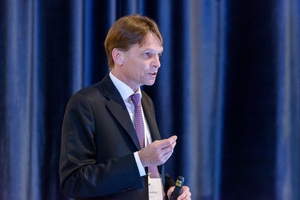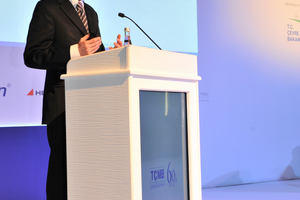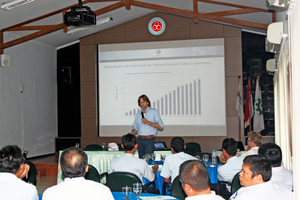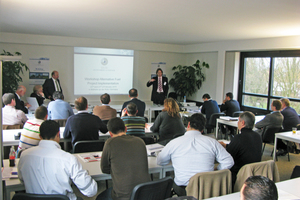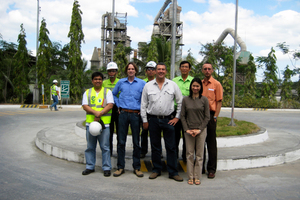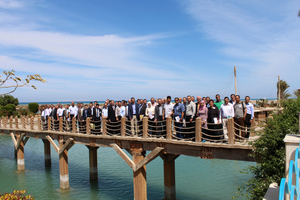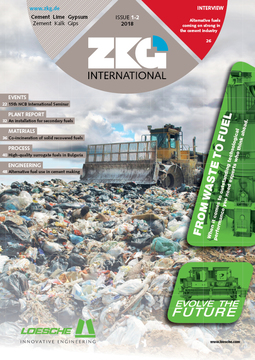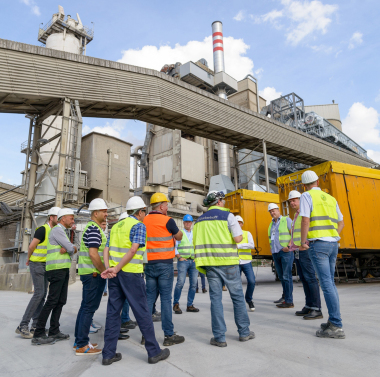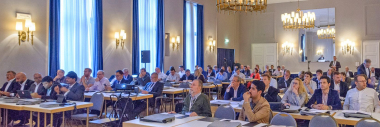Alternative fuels coming on strong in the cement industry
Dirk Lechtenberg and his consulting firm MVW Lechtenberg & Partner have been serving the cement industry in connection with alternative fuels for many years now. We spoke with him about the present and future situation of alternative fuels as energy carriers for the cement sector.
LECHTENBERG: The general trend is that nearly all cement plants all over the world are dealing intensively with the subject of alternative fuels (refuse-derived, solid/specified recovered, etc.), each for their own reasons.
This is most specifically the case in the Middle East, where governments are seen to be gradually reducing their energy subsidies. Egypt stands as a typical example. After the Arab Spring, the government was no longer able to provide the plants with gas, and many of them had to shut down for weeks on end for lack of energy. Then, Egypt implemented a new set of rules allowing cement plants to use coal on condition that a certain minimum amount of alternative/secondary fuel also be employed. Things like biomass and refuse-derived fuel (RDF) count as alternative fuels. This provision is expected to eventually account for about 30 %. In other words, in the future, Egyptian cement plants will have to use between 20 % and 30 % alternative fuels in order to meet the law. Otherwise, they would not be allowed to import any coal. The fact is that most plants have already converted from gas to coal in order to remain competitive, so they are investing heavily in the use of alternative fuels.
The situation is exactly the same right now in Saudi Arabia, too. Three years ago, the Saudis began to develop a “Mandatory Energy Efficiency Programme”. As advisors to the Saudi-Arabian ministries of environment and infrastructure, we help pursue the goal of developing concepts for reducing energy consumption throughout the country, particularly in the cement industry. It is an established fact that, in Saudi Arabia, some 30 % of all oil currently being produced goes for domestic consumption. In view of that huge amount, the government is trying to get both the consumers and the entire industry to use less energy. The trouble is, if you can get a ton of heavy fuel oil for $30, why should you worry about saving energy? So now, the government has begun to ratchet up the cost of energy, and cement plant operators are beginning to fear that they may be having to pay world-market prices for energy by the time next summer comes around. That, of course, is making them take a very keen interest in alternative fuels.
LECHTENBERG: Four Saudi Arabian cement plants are presently using alternative fuels, primarily in the form of used tires, oil and solvents. One plant is even test-processing domestic waste. Of Saudi Arabia’s overall clinker production capacity amounting to a little over 50 million t/a, only a tiny fraction, less than 1 %, is being made with alternative fuels. Things are just getting started, especially in view of the fact that the whole thing is still absolutely uneconomical. A few of the more innovative plant operators, however, are thinking ahead. They are working to either develop appropriate concepts or even build the systems they will need to effect a direct switchover as soon as the cost of energy rises to the trigger point.
LECHTENBERG: Our projects often include the involvement of policy makers and national governments. Many countries have no legal provisions covering the use of alternative fuels. Consequently, it is difficult for plant operators to obtain the appropriate permits. In many areas, it takes real groundwork to convince the government that the use of alternative fuels makes sense. Moreover, they need help in drafting the necessary regulations pertinent to the use of such substances. In Turkey, for example, we joined forces with the Turkish Cement Manufacturers’ Association (TÇMB) and the government to reach agreement on how best to use alternative fuels and on the conditions under which cement plants can employ such material. The next step, then, was to clarify how something like that can be financed.
LECHTENBERG: Most emerging and developing economies have no waste infrastructure whatsoever – with the possible exception of garbage collection. Such waste is dumped somewhere, but at such low cost that cement plants have little economic incentive to use the waste themselves. As mentioned, though, a relevant agreement has been reached in Turkey, and the government has presented a plan, according to which all cities with populations exceeding one million, of which there are around 30, will be required as of 2023 to have either a mechanical-biological waste treatment plant or a waste incineration facility. That, naturally enough, is causing the cement industry to ponder the available options for turning domestic waste into alternative fuel. We are presently engaged in five Turkish projects geared to having cement plants cooperate with local communities in developing concepts for processing domestic waste and using part of the output as alternative fuel for the plants themselves.
LECHTENBERG: As a rule, only homogeneous commercial and industrial waste is processed into refuse-derived fuel, since both types have high fuel values and homogeneous chemical and physical parameters, particularly with regard to their heat of combustion. Only a very few plants – perhaps three in all of Germany – actually use refuse-derived fuel. Past history is also a factor. Many German plants are still equipped with preheater kilns that can only operate on substitute fuel if the fuel value is high enough. Few plants are equipped with calcinator kilns, so accordingly few plant operators have ever looked seriously into the potential use of RDF.
LECHTENBERG: Change is surely on the way. Take Holcim in Lägerdorf, for example, where a new pre-combustion chamber now enables the use of low-calorific processed waste as fuel. HeidelbergCement in Schelklingen is working on plans to do the same. Looking abroad, especially toward the Middle East, where there are many modern calcinator kilns in operation, we see a lot of real concentration on domestic waste. However, a clinker kiln line with an output of, say, 10 000 t/d would require a huge volume flow of domestic waste, because only somewhere between 20 % and 50 % of the waste is actually serviceable as an alternative fuel, depending on its actual composition.
LECHTENBERG: The cost of energy in the United States is so low, that it would hardly be worthwhile for cement plants to adopt alternative fuels. The requisite infrastructure is lacking, and the regulatory framework is less than ideal. Nevertheless, there are a number of ongoing projects in the U.S.A. and Canada.
LECHTENBERG: That is a major problem. Here in Western Europe, we take waste infrastructure for granted and that the waste originator always has to pay a fee for the waste’s subsequent processing. But then, waste always takes the path of least resistance, i.e., in countries where landfilling is no longer allowed, the waste is more likely to be utilized, and the least-cost processing option is where the waste is going to land. This is very apparent on the German market. Three years ago, cement plants were paying ten to twenty €/t for a given alternative fuel with a defined high calorific value. Now, however, the suppliers are demanding between 20 and 35 €/t for the same alternative fuel. Rates, fees and top-up payments are always subject to the principle of supply and demand.
The situation is similar in emerging and developing countries with no waste disposal infrastructure. Frequently, cement plants have to compete with low-cost landfills. In many countries, cement plants finance all or part of the entire processing chain and then set the cost off in relation to fossil fuels. Most of our projects are located in emerging and developing countries, where cement plants pay as much as 35 €/t for high-energy alternative fuel.
In Tel Aviv, Israel, for example, we implemented a major project in which alternative fuels are produced at the rate of 250 000 t/a. Since the waste in question carries disposal/recycling fees, and since the only competition is a landfill located some 150 km outside of Tel Aviv, a local cement plant is able to obtain the fuel on a cost-neutral basis. On the other hand, quite substantial initial investments were necessary for processing the waste and for effecting the necessary modifications to the cement plant itself: receiving stations, storage, licensing procedures, emissions monitoring, etc.
LECHTENBERG: Even the big group enterprises are taking a very keen interest in the subject of alternative fuels. They realize that this has become the only way to produce cement both efficiently and economically. The big players have the necessary know-how. LafargeHolcim, for example, has established a special group of companies called Geocycle that is dedicated solely to developing concepts for the production of alternative fuels, building the corresponding plants and then supplying the fuel thus produced to their own factories. The group operates as a specialized service provider not only for LafargeHolcim, but also for local authorities and diverse industrial enterprises.
In many countries, they start with industrial waste, i.e., liquid waste, used oil, solvents, etc., and then gradually add one thing after another. Many groups have adopted very ambitious goals in terms of substitution rates.
Some groups are both very large and very sluggish – like a tanker. It takes time to get a tanker going, but once it is on the move, it is hard to stop. After the last financial crisis, many of the large groups were facing major problems and therefore had to attend to more pressing things first. Since then, however, the question of which strategy to pursue in connection with alternative fuels has become a board-level issue in all large groups. Cement producers must think far ahead. Their decisions on building new plants, concluding long-term contracts for raw material, technology, etc., remain binding for a long time. In the waste sector, though, the decisions to be made are day-to-day business. Often, snap decisions are called for, and high-level flexibility is a must. That, of course, is very difficult to incorporate into the structure of a long-term-thinking group enterprise, because the effect is a clash of two different corporate cultures. That is why privately owned plants and small groups tend to enjoy the substantial benefits of being able to (re)act more flexibly.
LECHTENBERG: The Chinese are well on their way to showing us how to use alternative fuels. Just look at the Anhui Conch projects: within the next year or two, they will be burning as much alternative fuel as the rest of the world together. That is surely attributable to the local political structure. When the party and government decide to say, “We are now going to use alternative fuels”, then that is what happens. There, the search is on for pragmatic solutions for the big cities’ waste problems. Such solutions tend to be combinations of waste incineration plants and recycling facilities for reclaimable substances and materials. This is where part of the local waste volumes is diverted for use as alternative fuel in the cement industry. Such facilities are funded, built and operated by the cement-producing groups themselves.
I can well remember a time seven or eight years ago, when a delegation of Chinese bank representatives was visiting here in Germany. We toured a number of cement plants where alternative fuels were in use. This practice-proven business model pleased the Chinese so well, that from then on to this day, any cement plant in China that wants to install or operate such a system receives the necessary financing without delay.
Indeed, the Chinese are presently putting in numerous waste incineration plants. The requisite equipment in terms of grates, boilers, etc., is produced directly in China on license from German or European companies. But, except for a few core components that are also produced on license, they build all the rest themselves.
LECHTENBERG: I see absolute excess capacity in many countries. Just consider the Middle East, where the clinker production capacity already stands at 150 million t/a, and yet, even more plants are still being built. Turkey, too, is busy putting up additional plants, as are Saudi Arabia and Egypt. They are all waiting for the situation in Syria to calm down (or, for that matter, in Yemen, Libya, and so on) so they can start exporting to those points. In reality, though, those countries cannot possibly absorb so much cement. Consequently, plant operators are trying to cut costs, and using alternative fuels is the best way to do so. When 50 % of your production outlays goes for energy, and you see a chance to reduce that by half, then we’re talking about tremendous potential savings. Everyone is getting into the game, so to speak.
LECHTENBERG: Most plant operators are only interested in saving money. Luckily, there are also lots of factory owners who want to do something for the environment, too. They think, “We can serve the general public by properly utilizing at least part of the incident waste. And, in doing so, we can pare down our CO2 emissions.” Then, one step further down the line, every such owner, operator or employee notices that, “… it’s also good for the environment”. Unfortunately, though, the cost benefit is what counts the most. There are actually a few stakeholders who would like to use alternative fuels to help the environment but cannot do so due to cost considerations. As long you’re enjoying low-cost oil, why should you pay two or three times as much for alternative fuels? That would not only make no sense, it would also make you uncompetitive.
Be that as it may, our numerous ongoing projects show that the use of alternative fuels and raw materials is going to increase dramatically. By now, everyone knows and accepts the fact that - Wow! – those are alternative fuels, and they have been doing the job right in Europe for a long time. They’re helping to save money, and they’re good for the environment, so let’s just do it.
LECHTENBERG: Relatively few, especially during the period you mentioned. I was unable to find any decent kind of shredder for producing a specific particle size. Once they finally became available, the plants became more energy efficient, i.e., they stopped expending so much energy per ton of waste. Sorting technology, too, has made great progress in recent years. Now, they are even able to pick different colors of glass out of a mixed flow of waste. Modern sorting systems can separate waste materials according to color or raw material composition. Such modern systems are popping up all over, especially in newly industrializing countries. The preparation plant at Nesher Cement in Israel, which cost $55 million, can split domestic waste up into as many as 50 different fractions: polypropylene, polyethylene, polyamides, polyester, aluminum, ferrous and non-ferrous metals, … - all sorted out and separated. Even different kinds of paper can now be classified as white paper, newspaper, cardboard, etc. It’s all state of the art now.
LECHTENBERG: Yes. While $55 million does sound like a lot of money, the plant has an annual domestic-waste processing capacity of 550 000 t. Here in Germany, a simple DSD recyclable “Green Dot” waste sorting facility costs between 30 and 40 million € – and that is just for the equipment. The shelter and attendant infrastructure cost extra, and the sorting capacity only amounts to roughly 150 000 t of packaging waste per year. Most plants are relatively small, having cost only 12 – 15 million €, but many of them are already outdated. Indeed, hardly anyone in Germany is presently investing in sorting systems.
LECHTENBERG: Because no one knows where the market will be going in the long run. For example, the lawmakers might probably decide to abolish the Dual System. In fact, that possibility is a subject of strong debate right now. Cost pressure is also a factor, of course. As long as you can keep a written-off old plant in operation, you will be able to produce more economically, despite the presently favorable interest rates.
Out there in the emerging economies, though, it is clear to see that such modern preparation plants actually are being built to supply closely defined alternative fuels for the cement industry. We are working on one such project in Cape Town, South Africa, right now. Having learned by experience how to process waste here in the West, we can take a very pragmatic approach to the subject down there. What counts is what makes sense for the environment, and what makes sense for the budget. The idea is to develop the best local solutions on that basis.
Naturally, the cement industry is going along with the trend and is strongly committed to the public weal in the emerging economies. That, of course, engenders acceptance by the people. Great emphasis is being placed on straightforward communication with the people. Having learned from past errors, the industry is now talking straight to the people of the neighborhood, the citizenry in general and the competent authorities to explain what is planned and how it is to be done – so as to get the people involved.
Twenty or thirty years ago, when a waste incineration plant was to be installed somewhere, the locals immediately protested. Back then, the installation of a waste incineration plant actually was a more extreme situation. But now, people know that a very strict set of environmental laws is in place and being monitored. And that the benefits outweigh the risks, when alternative fuels are used. All that is helpful. For the apple farmer who makes a living growing apples next to the cement plant, it is reassuring to hear that his apples are not going to be polluted and will therefore remain marketable. Such people have to be won over, so that they can pass the word. That really works, as we have seen in numerous projects. In Pakistan, for example, where the owner of a cement plant realized how advantageous it would be to use alternative fuels. Let me name just one example: Once, when I was on the road with the owner of a cement plant somewhere between Lahore and the Afghan border, we were looking around for the kind of waste that would be suitable for processing. We happened upon a little village where the people simply tossed all their garbage into a nearby stream. I told the cement plant operator that, if he were to simply give the people garbage cans and tell them that he intended to collect their garbage and process it at his cement plant, they would realize that not only would he be gaining an alternative fuel, but that they themselves would stand to gain a cleaner village. Perhaps a little school could be built for giving the people further education. Well, that is precisely what he did, and when I returned two years later and drove through that same little village with him, I saw that it was completely clean. Yes, the cement industry really can do things like that. It costs nothing and secures a supply of fuel for the cement plant.
Many cement plants now have their own visitors’ center, where they can invite school classes to come and see how cement is produced.
LECHTENBERG: Yes, being open and aboveboard is conducive to youth retention. Many cement plants, especially in emerging countries, also offer (advanced) training courses, cooperate with universities and talk openly about the advantages and disadvantages of using alternative fuels, because they have learned lessons from past mistakes.
LECHTENBERG: First, gather information. Attend one or other of the relevant conferences. Talk to other cement plant operators who are already using alternative fuels (to the extent that they are willing to divulge any information). Unfortunately, it is often the case that cement producers do not want to go into detail. Next, set up a team for developing a concept, and send its members off to seminars, symposia, workshops and such to get them acquainted with the material. Later on, you can take an experienced consultant on board and (re)visit various cement plants to see what kind of technology would be appropriate and where the respective pros and cons lie. It takes a lot of expertise to successfully implement such a project. And, if you are trying to design and implement such a system on your own, you will find that it is a long, hard row to hoe. Here at Lechtenberg & Partner’s, we routinely host students from various different universities that we like to work with, e.g., the University of Indonesia in Jakarta, the University of Marrakesh in Morocco, the German-Jordanian University (GJU) in Amman and the American University of Beirut, Lebanon, all of whom regularly send us their best students for a number of months to do an internship and learn how to deal with the subject of alternative fuels. We then try to get the students jobs at local cement plants. That works quite well. In Indonesia, we have three students working at Indocement Tunggal Prakasa (HeidelbergCement). They carry on with and refine the projects for the companies by using the basic hand tools we give them and by working together with the Institute of Technology in Darmstadt (TU Darmstadt), with whom we also collaborate, as well as with a number of local cement plants. Thus, the trainees gain some initial insight into the day-to-day workings of a cement plant. They can see how the alternative fuels arrive by road vehicles and learn how samples are obtained and processed, and how all this impacts the clinker production process. It’s all very practice-oriented. The students spend a whole week helping out at a waste processing plant and can see first-hand how an alternative fuel is produced.
LECHTENBERG: Yes, we regularly hold workshops and trainings at cement plants, either individually or, in some countries, for several cement plants together. The workshops and trainings we hold here in Duisburg are designed for small groups of 20 or less to enable specific, close attention to a given topic such as hazardous waste or how waste is processed. Over the past ten years, some 2500 people have attended our practical and theoretical training courses. At the plants themselves, we break the training down into two or three separate steps.
We also work together with the cement associations. Last January in Turkey, for example, we organized an event for the Turkish Cement Manufacturers’ Association (TÇMB) that was attended by representatives from all Turkish cement plants, all major Turkish municipalities and the relevant ministries. We discussed how to carry on from there and how we as an industry can help communities dispose of their waste.
LECHTENBERG: We advise authorities like Germany’s Federal Environmental Agency, and we are presently conducting numerous audits at various incineration plants, paper factories, coal-fired power stations and brickyards, hence covering practically the entire industrial sector. This is a very interesting topic. Our planning engineers devise concepts for waste incineration plants and draw up tendering documents for waste processing and incineration facilities in Germany and abroad. Right now in Israel, we are working on invitations to tender for three waste incineration plants, and we have already finished work on two such projects in Beirut. Afterwards, we will analyze the tenders and develop the concepts.
Our service division provides support to cement plants with no real desire to deal with the subject of waste utilization. This can go all the way to having us deliver alternative fuels. We supply very high-energy grades of refuse-derived fuel (RDF with at least 25 MJ/kg) from our storage facility (licensed for 16 000 t) at the Papenburg harbor. We source the material from presently 18 sorting facilities in Germany and supply closely specified fractions to the cement plants on a just-in-time schedule.
LECHTENBERG: The last two years have seen an upward trend in the use of secondary fuels. There are numerous ongoing projects of relevance, especially in China. In my view, there will be a massive increase in the use of alternative fuels over the next five years.
//www.lechtenberg-partner.de" target="_blank" >www.lechtenberg-partner.de:www.lechtenberg-partner.de

